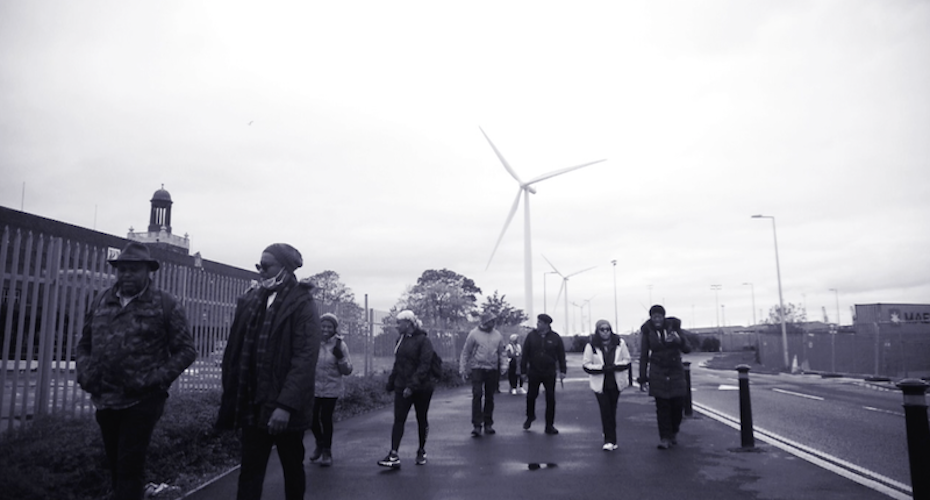Walking in the Wake
McMillan was commissioned by Black British artist, Elsa James to create Walking in the Wake, a 20 min B&W film made in collaboration with sonic/visual artists Dubmorphology (Gary Stewart & Trevor Mathison) for the Estuary Festival 2021.
Film of twelve Black pilgrims walking along the River Thames estuary is overlaid with imagery of maritime sites of Empire they encounter. This is contextualised by McMillan’s voice over narrative that includes a meditation on Joseph Conrad’s 1899 novella Heart of Darkness. The texture and depth of B&W film gives the film a poetic timelessness.
Walking in the Wake was screened online on Saturday 22 & 23 Sunday May, 2021 as part of the festival. See film here.
Stills from Walking in the Wake
The walks starts at Tilbury Cruise Terminal, where arrival of the HMT Empire Windrush on Tuesday 22 June 1948 will begin post-war Caribbean migration to Britain. Everton Wright’s installation here, Tilbury Bridge Walkway of Memories that includes archive photographs captures this moment.
At Gravesend, Charlie Marlow from Conrad’s Heart of Darkness, will begin his journey to the Congo River, Central Africa, in search of Kurtz, an ivory trader, who has monopolised his colonial position to become a brutal demigod among the local Africans.
At Tilbury Fort, Queen Elizabeth I rallied the English fleet to defend her realm against the invading Spanish Armada, and where she knighted Sir Francis Drake for his piracy in the transatlantic slave trade. The industrial revolution is marked by Coalhouse Fort where coal brought by sea was offloaded and stored. Whereas Second World War defence fortifications symbolise Britain’s long island siege mentality against invasion.
The film’s title Walking in the Wake comes from curator Christine Sharpe’s 2016 book, In the Wake: On Blackness and Being that Black life and death is always in the wake in impeding serial trauma. McMillan’s voiceover narrative contemplates the wake of a moving slave ship, ships of Empire, container ships of globalisation, and afterlife of the Windrush Scandal.
Finally, McMillan reflects on church outings to seaside towns like Margate and Great Yarmouth, going on a Boy Scout trip, and an Anti-Apartheid charity walk in Epping Forest as a commentary on visibly invisible Black bodies in the English countryside. The County of Essex that the River Thames goes through, as an overspill from London’s East End is often portrayed as white working class, yet there are migrant, largely West African communities settled there now, which reflects a constant historic Black presence in the region.
Josephine Crawford Melville
(1961-2022) British actress, director and writer of Jamaican migrant heritage, who was born and lived in Essex, and one of the twelve pilgrim walkers.








